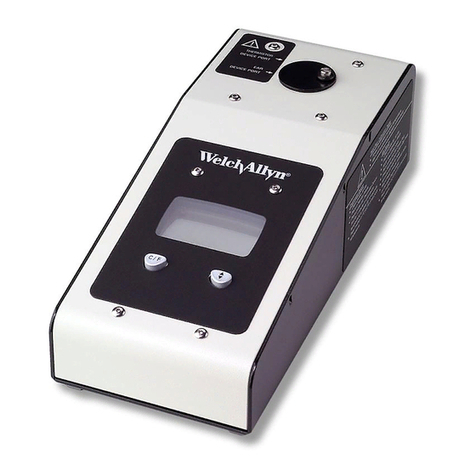
THE MODEL 9000 AND MODEL 9020 THERMOMETER
1. The Model 9000 (InstaTemp® and ThermoGuide™) Thermometer can
be placed into a special Test Mode for checking the calibration using the
9600 System.
The Test Mode is entered by simultaneously pressing the PULSE,
TIMER, and MODE switches and is signified by a ‘T’ displayed on the
thermometer LCD.
The Test Mode will remain on as long as the “pulse timer” is active.
Once in the Test Mode, the mode may be extended by repeatedly
pressing the PULSE TIMER switch only. The Test Mode is exited
automatically when the “pulse timer” times out. The thermometer mode
will then change back to the thermometer mode prior to entering the
Test Mode. The Test Mode may be exited before the “pulse timer”
times out by pressing the MODE switch only. This will cause the
thermometer mode to change to the ORAL mode.
NOTE: For thermometers having serial numbers less than 25000, the Test
Mode is entered as an Operation Mode by repeatedly pushing the MODE
switch, For these thermometers, the Test Mode will remain until the mode is
manually changed - it will not automatically change back to the previous mode.
2. When the ready indicator is visible, push the slide forward to place a
probe cover on the sensor.
3. Inspect the probe cover for integrity. If the probe cover is damaged,
retract the slide fully to remove the damaged probe cover, When the
ready indicator is visible, push the slide forward to replace the probe
cover and then reinspect the integrity of the new cover.
4. Lift the flap and insert the tip of the Model 9000 Thermometer into the
large opening on the 9600 Calibration Tester until it rests on top,
perpendicular to the tester.
5. Immediately after inserting the thermometer, depress the scan button
until you hear the temperature completed beep (about 3 seconds), then
remove the thermometer from the 9600 Tester.
6. Verify that the reading on the Model 9000 Thermometer is within the
following tolerances:
96.4ºF Setting: 96.1ºF to 96.7ºF
106.0ºF Setting: 105.7ºF to 106.3ºF
8
WelchAllyn9600CalibrationTester




























